Analyzing Contemporary Accounting Issues: A Case Study of ANZ Bank
VerifiedAdded on 2023/05/28
|16
|2313
|290
Case Study
AI Summary
This case study examines the application of the Conceptual Framework (CF) in financial reporting by the Australia and New Zealand Banking Group Limited (ANZ), highlighting instances of accounting malpractices and comparing ANZ's compliance with that of AMA Group Limited. It analyses ANZ's 2018 annual report, focusing on adherence to Generally Accepted Accounting Principles (GAAP), Australian Accounting Standards (AASs), and International Financial Reporting Standards (IFRSs). The study identifies concerns regarding excessive managerial remuneration and evaluates the effectiveness of corporate reporting, considering the principle of 'substance over form' and agency theory. The report concludes with recommendations for improved corporate governance and reporting practices, emphasizing the importance of both financial and non-financial elements in ensuring long-term sustainability. Desklib provides a platform for students to access past papers and solved assignments related to this topic.
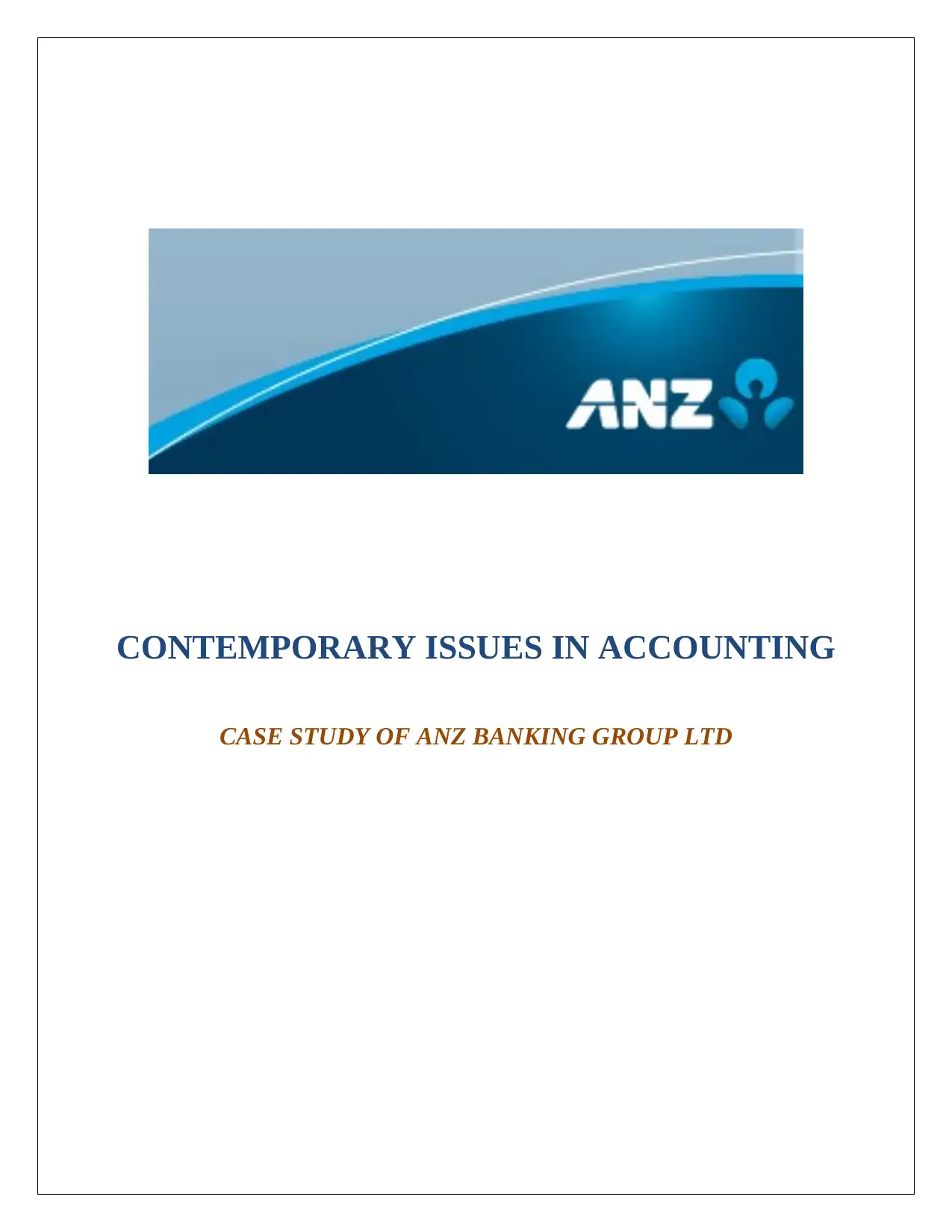
CONTEMPORARY ISSUES IN ACCOUNTING
CASE STUDY OF ANZ BANKING GROUP LTD
CASE STUDY OF ANZ BANKING GROUP LTD
Paraphrase This Document
Need a fresh take? Get an instant paraphrase of this document with our AI Paraphraser
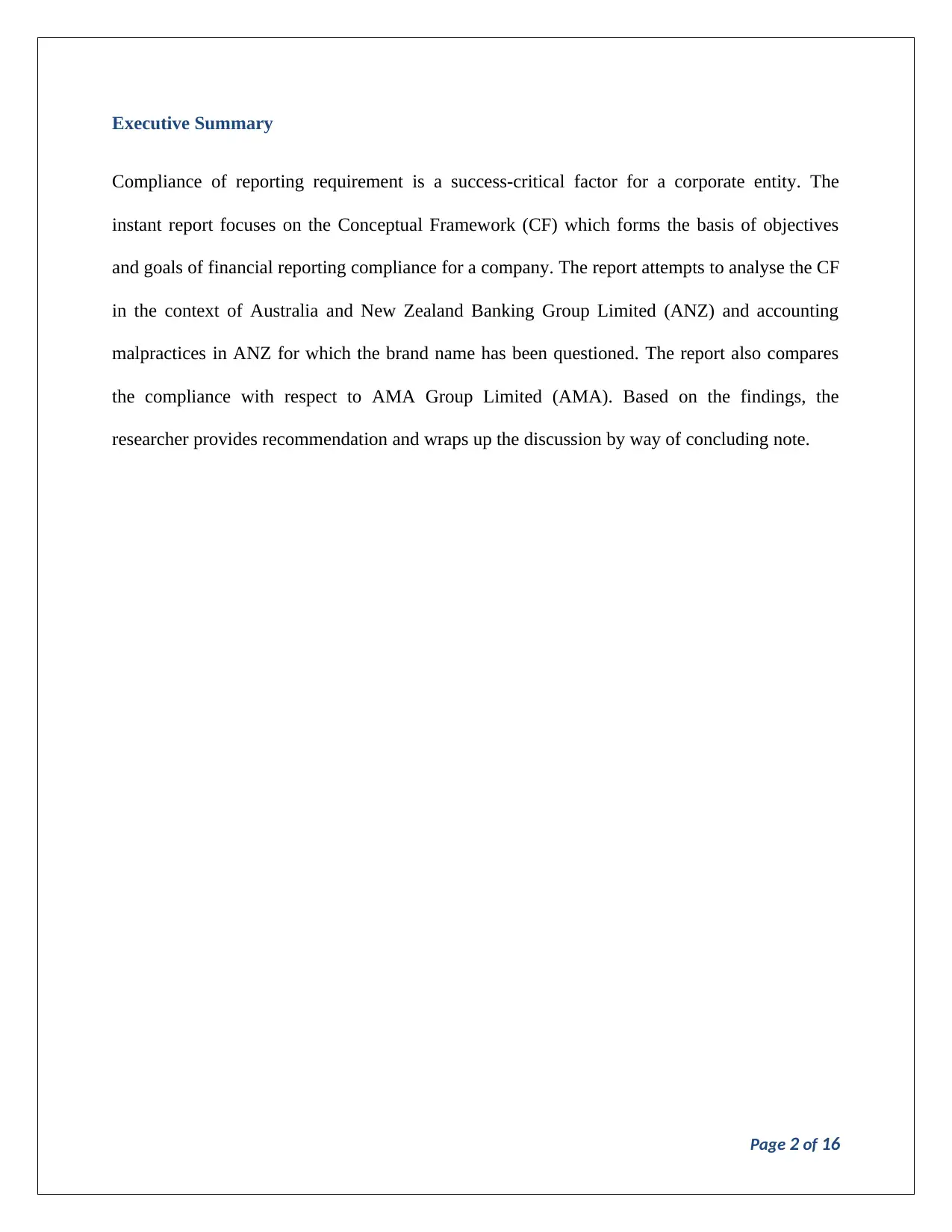
Executive Summary
Compliance of reporting requirement is a success-critical factor for a corporate entity. The
instant report focuses on the Conceptual Framework (CF) which forms the basis of objectives
and goals of financial reporting compliance for a company. The report attempts to analyse the CF
in the context of Australia and New Zealand Banking Group Limited (ANZ) and accounting
malpractices in ANZ for which the brand name has been questioned. The report also compares
the compliance with respect to AMA Group Limited (AMA). Based on the findings, the
researcher provides recommendation and wraps up the discussion by way of concluding note.
Page 2 of 16
Compliance of reporting requirement is a success-critical factor for a corporate entity. The
instant report focuses on the Conceptual Framework (CF) which forms the basis of objectives
and goals of financial reporting compliance for a company. The report attempts to analyse the CF
in the context of Australia and New Zealand Banking Group Limited (ANZ) and accounting
malpractices in ANZ for which the brand name has been questioned. The report also compares
the compliance with respect to AMA Group Limited (AMA). Based on the findings, the
researcher provides recommendation and wraps up the discussion by way of concluding note.
Page 2 of 16
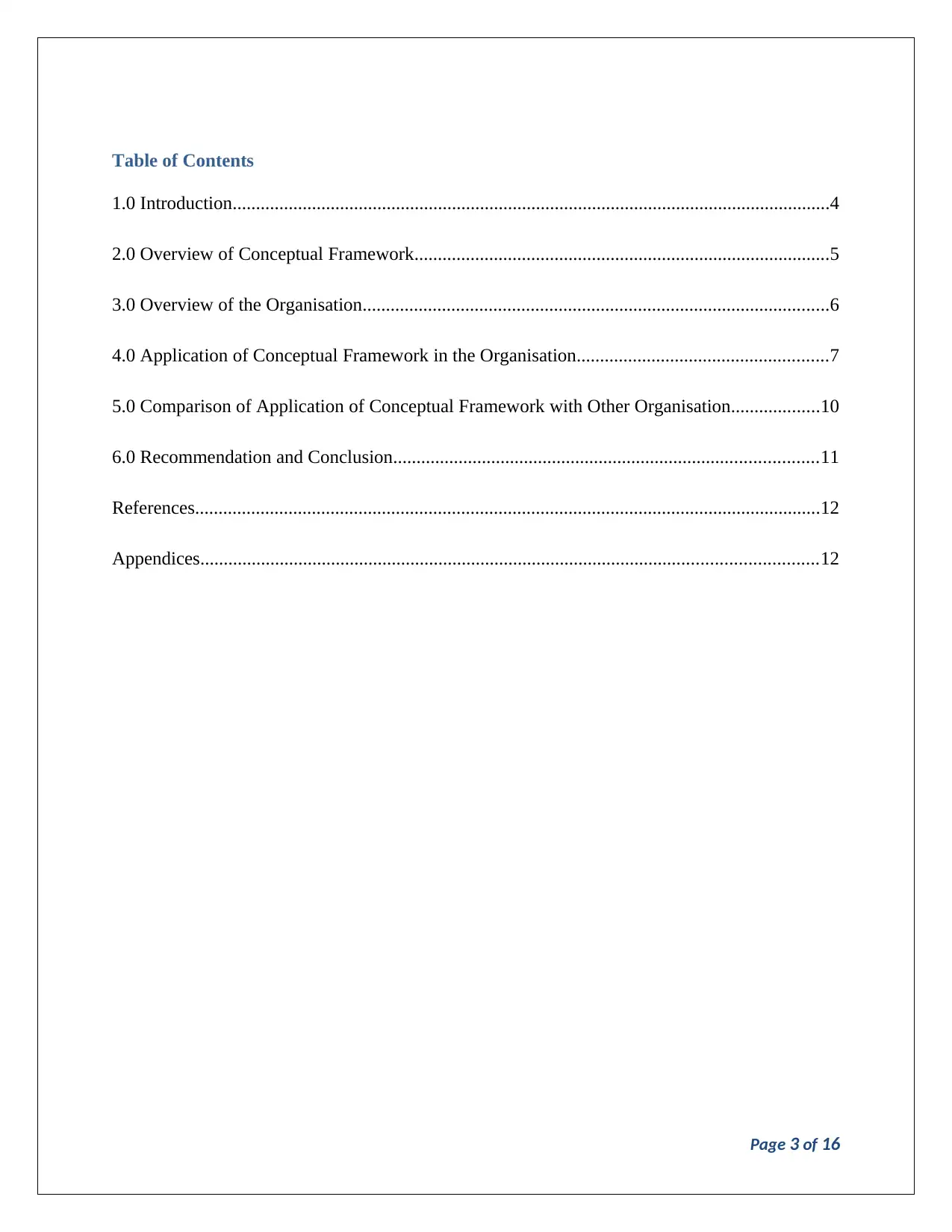
Table of Contents
1.0 Introduction................................................................................................................................4
2.0 Overview of Conceptual Framework.........................................................................................5
3.0 Overview of the Organisation....................................................................................................6
4.0 Application of Conceptual Framework in the Organisation......................................................7
5.0 Comparison of Application of Conceptual Framework with Other Organisation...................10
6.0 Recommendation and Conclusion...........................................................................................11
References......................................................................................................................................12
Appendices....................................................................................................................................12
Page 3 of 16
1.0 Introduction................................................................................................................................4
2.0 Overview of Conceptual Framework.........................................................................................5
3.0 Overview of the Organisation....................................................................................................6
4.0 Application of Conceptual Framework in the Organisation......................................................7
5.0 Comparison of Application of Conceptual Framework with Other Organisation...................10
6.0 Recommendation and Conclusion...........................................................................................11
References......................................................................................................................................12
Appendices....................................................................................................................................12
Page 3 of 16
⊘ This is a preview!⊘
Do you want full access?
Subscribe today to unlock all pages.

Trusted by 1+ million students worldwide
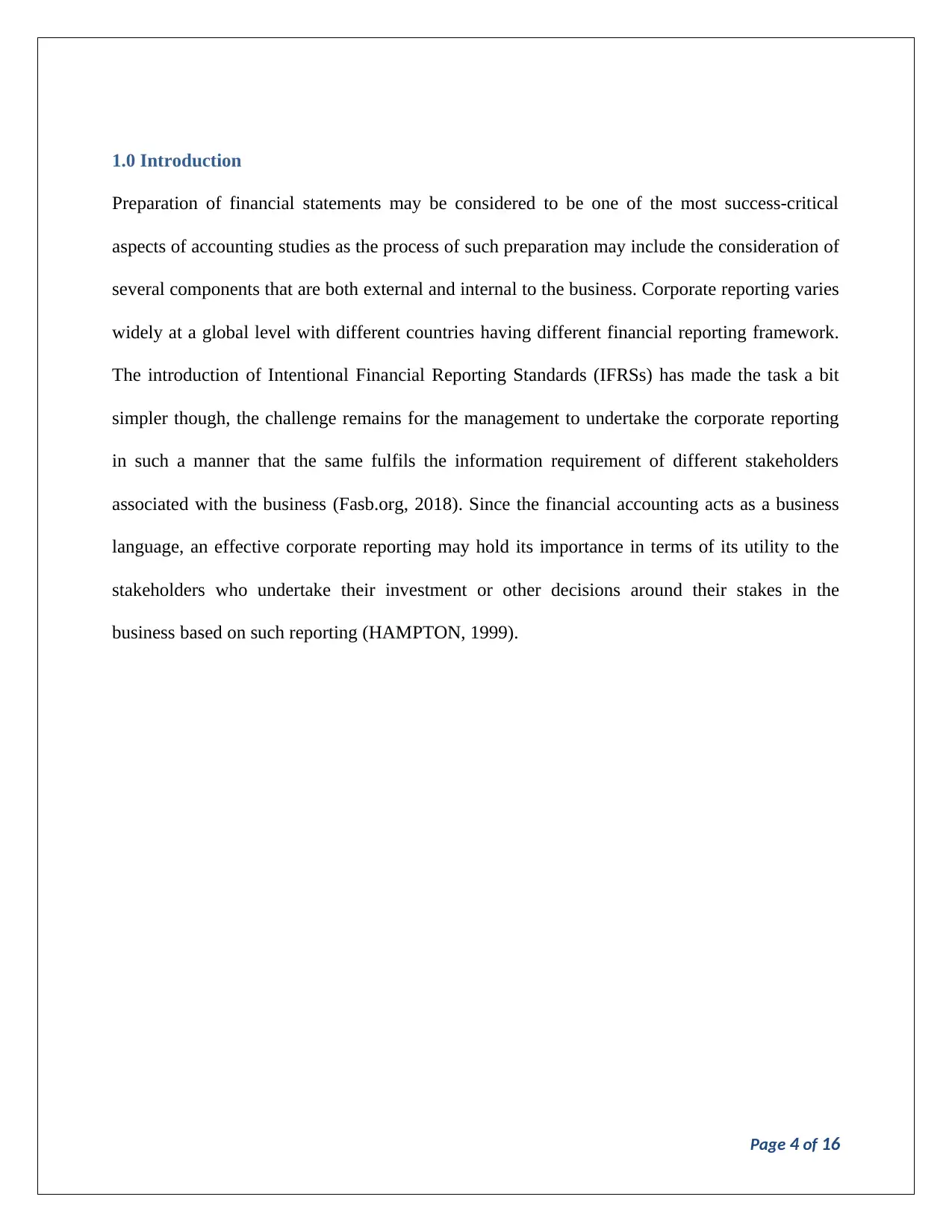
1.0 Introduction
Preparation of financial statements may be considered to be one of the most success-critical
aspects of accounting studies as the process of such preparation may include the consideration of
several components that are both external and internal to the business. Corporate reporting varies
widely at a global level with different countries having different financial reporting framework.
The introduction of Intentional Financial Reporting Standards (IFRSs) has made the task a bit
simpler though, the challenge remains for the management to undertake the corporate reporting
in such a manner that the same fulfils the information requirement of different stakeholders
associated with the business (Fasb.org, 2018). Since the financial accounting acts as a business
language, an effective corporate reporting may hold its importance in terms of its utility to the
stakeholders who undertake their investment or other decisions around their stakes in the
business based on such reporting (HAMPTON, 1999).
Page 4 of 16
Preparation of financial statements may be considered to be one of the most success-critical
aspects of accounting studies as the process of such preparation may include the consideration of
several components that are both external and internal to the business. Corporate reporting varies
widely at a global level with different countries having different financial reporting framework.
The introduction of Intentional Financial Reporting Standards (IFRSs) has made the task a bit
simpler though, the challenge remains for the management to undertake the corporate reporting
in such a manner that the same fulfils the information requirement of different stakeholders
associated with the business (Fasb.org, 2018). Since the financial accounting acts as a business
language, an effective corporate reporting may hold its importance in terms of its utility to the
stakeholders who undertake their investment or other decisions around their stakes in the
business based on such reporting (HAMPTON, 1999).
Page 4 of 16
Paraphrase This Document
Need a fresh take? Get an instant paraphrase of this document with our AI Paraphraser
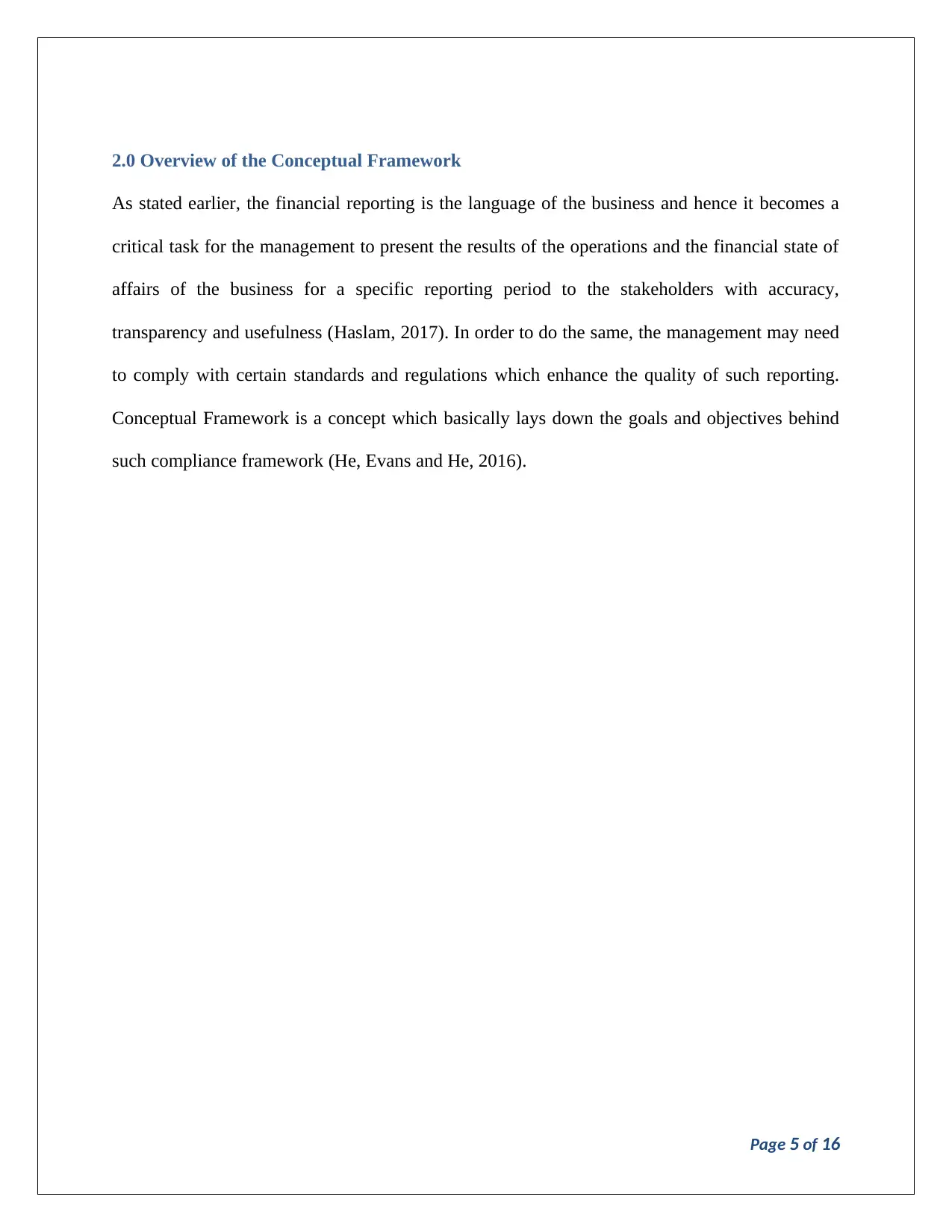
2.0 Overview of the Conceptual Framework
As stated earlier, the financial reporting is the language of the business and hence it becomes a
critical task for the management to present the results of the operations and the financial state of
affairs of the business for a specific reporting period to the stakeholders with accuracy,
transparency and usefulness (Haslam, 2017). In order to do the same, the management may need
to comply with certain standards and regulations which enhance the quality of such reporting.
Conceptual Framework is a concept which basically lays down the goals and objectives behind
such compliance framework (He, Evans and He, 2016).
Page 5 of 16
As stated earlier, the financial reporting is the language of the business and hence it becomes a
critical task for the management to present the results of the operations and the financial state of
affairs of the business for a specific reporting period to the stakeholders with accuracy,
transparency and usefulness (Haslam, 2017). In order to do the same, the management may need
to comply with certain standards and regulations which enhance the quality of such reporting.
Conceptual Framework is a concept which basically lays down the goals and objectives behind
such compliance framework (He, Evans and He, 2016).
Page 5 of 16
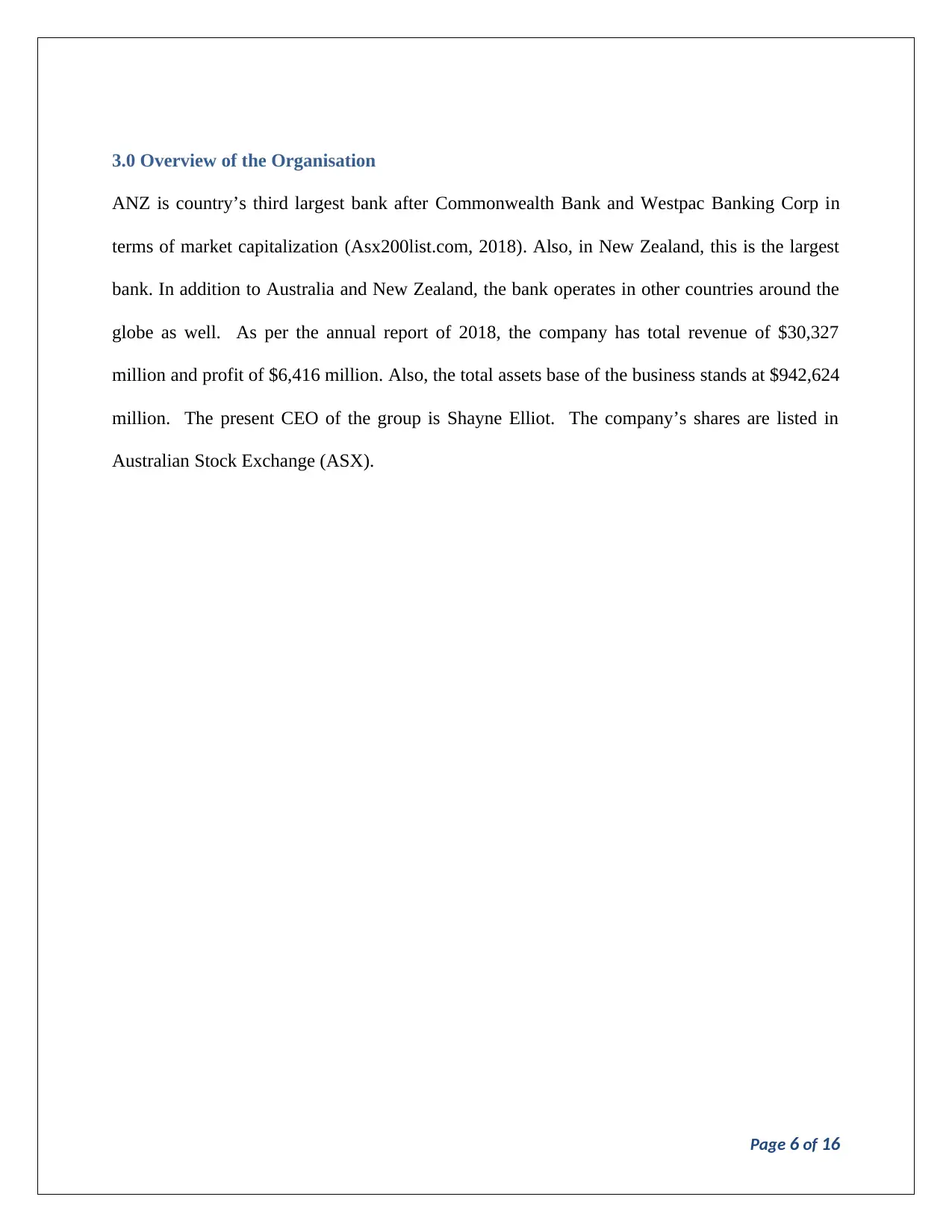
3.0 Overview of the Organisation
ANZ is country’s third largest bank after Commonwealth Bank and Westpac Banking Corp in
terms of market capitalization (Asx200list.com, 2018). Also, in New Zealand, this is the largest
bank. In addition to Australia and New Zealand, the bank operates in other countries around the
globe as well. As per the annual report of 2018, the company has total revenue of $30,327
million and profit of $6,416 million. Also, the total assets base of the business stands at $942,624
million. The present CEO of the group is Shayne Elliot. The company’s shares are listed in
Australian Stock Exchange (ASX).
Page 6 of 16
ANZ is country’s third largest bank after Commonwealth Bank and Westpac Banking Corp in
terms of market capitalization (Asx200list.com, 2018). Also, in New Zealand, this is the largest
bank. In addition to Australia and New Zealand, the bank operates in other countries around the
globe as well. As per the annual report of 2018, the company has total revenue of $30,327
million and profit of $6,416 million. Also, the total assets base of the business stands at $942,624
million. The present CEO of the group is Shayne Elliot. The company’s shares are listed in
Australian Stock Exchange (ASX).
Page 6 of 16
⊘ This is a preview!⊘
Do you want full access?
Subscribe today to unlock all pages.

Trusted by 1+ million students worldwide
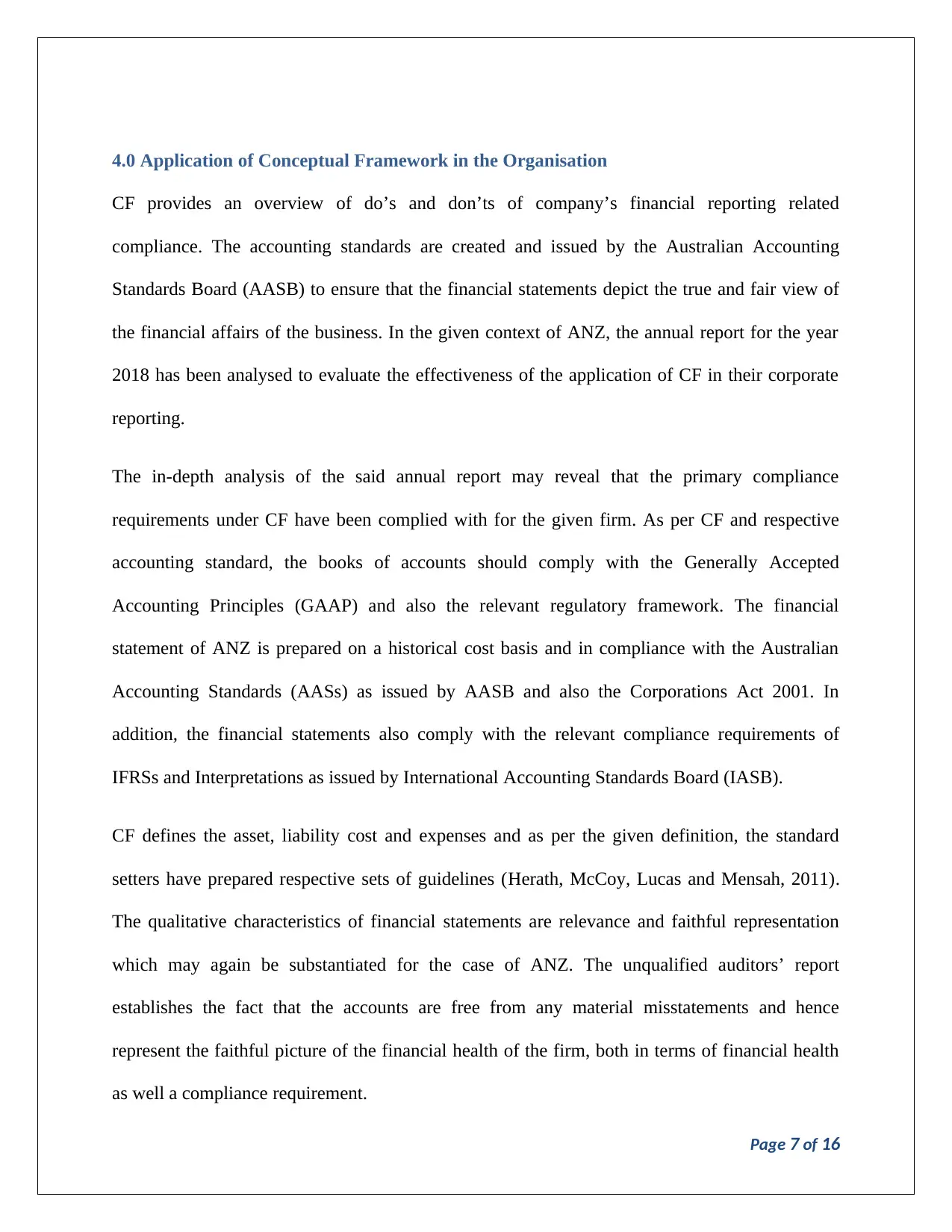
4.0 Application of Conceptual Framework in the Organisation
CF provides an overview of do’s and don’ts of company’s financial reporting related
compliance. The accounting standards are created and issued by the Australian Accounting
Standards Board (AASB) to ensure that the financial statements depict the true and fair view of
the financial affairs of the business. In the given context of ANZ, the annual report for the year
2018 has been analysed to evaluate the effectiveness of the application of CF in their corporate
reporting.
The in-depth analysis of the said annual report may reveal that the primary compliance
requirements under CF have been complied with for the given firm. As per CF and respective
accounting standard, the books of accounts should comply with the Generally Accepted
Accounting Principles (GAAP) and also the relevant regulatory framework. The financial
statement of ANZ is prepared on a historical cost basis and in compliance with the Australian
Accounting Standards (AASs) as issued by AASB and also the Corporations Act 2001. In
addition, the financial statements also comply with the relevant compliance requirements of
IFRSs and Interpretations as issued by International Accounting Standards Board (IASB).
CF defines the asset, liability cost and expenses and as per the given definition, the standard
setters have prepared respective sets of guidelines (Herath, McCoy, Lucas and Mensah, 2011).
The qualitative characteristics of financial statements are relevance and faithful representation
which may again be substantiated for the case of ANZ. The unqualified auditors’ report
establishes the fact that the accounts are free from any material misstatements and hence
represent the faithful picture of the financial health of the firm, both in terms of financial health
as well a compliance requirement.
Page 7 of 16
CF provides an overview of do’s and don’ts of company’s financial reporting related
compliance. The accounting standards are created and issued by the Australian Accounting
Standards Board (AASB) to ensure that the financial statements depict the true and fair view of
the financial affairs of the business. In the given context of ANZ, the annual report for the year
2018 has been analysed to evaluate the effectiveness of the application of CF in their corporate
reporting.
The in-depth analysis of the said annual report may reveal that the primary compliance
requirements under CF have been complied with for the given firm. As per CF and respective
accounting standard, the books of accounts should comply with the Generally Accepted
Accounting Principles (GAAP) and also the relevant regulatory framework. The financial
statement of ANZ is prepared on a historical cost basis and in compliance with the Australian
Accounting Standards (AASs) as issued by AASB and also the Corporations Act 2001. In
addition, the financial statements also comply with the relevant compliance requirements of
IFRSs and Interpretations as issued by International Accounting Standards Board (IASB).
CF defines the asset, liability cost and expenses and as per the given definition, the standard
setters have prepared respective sets of guidelines (Herath, McCoy, Lucas and Mensah, 2011).
The qualitative characteristics of financial statements are relevance and faithful representation
which may again be substantiated for the case of ANZ. The unqualified auditors’ report
establishes the fact that the accounts are free from any material misstatements and hence
represent the faithful picture of the financial health of the firm, both in terms of financial health
as well a compliance requirement.
Page 7 of 16
Paraphrase This Document
Need a fresh take? Get an instant paraphrase of this document with our AI Paraphraser
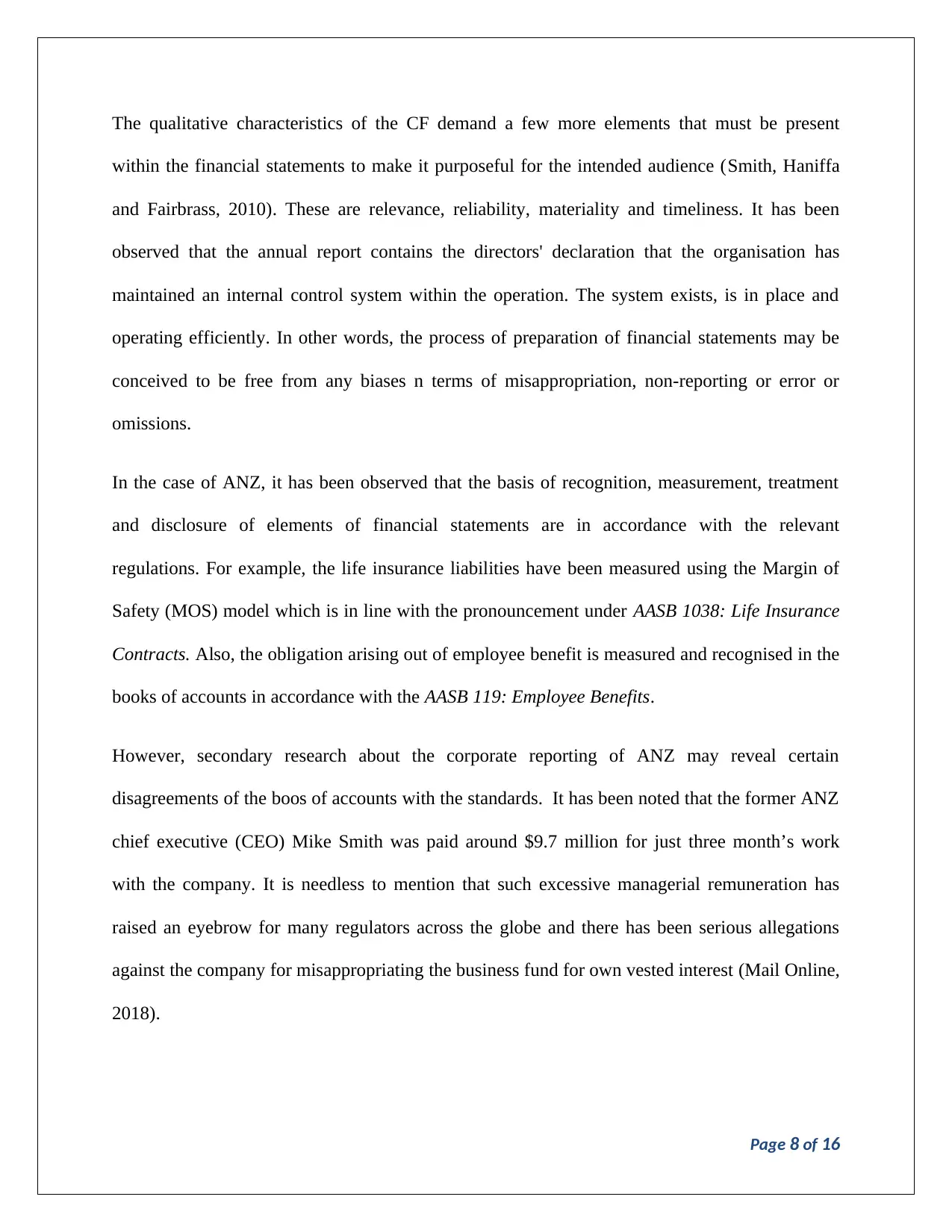
The qualitative characteristics of the CF demand a few more elements that must be present
within the financial statements to make it purposeful for the intended audience (Smith, Haniffa
and Fairbrass, 2010). These are relevance, reliability, materiality and timeliness. It has been
observed that the annual report contains the directors' declaration that the organisation has
maintained an internal control system within the operation. The system exists, is in place and
operating efficiently. In other words, the process of preparation of financial statements may be
conceived to be free from any biases n terms of misappropriation, non-reporting or error or
omissions.
In the case of ANZ, it has been observed that the basis of recognition, measurement, treatment
and disclosure of elements of financial statements are in accordance with the relevant
regulations. For example, the life insurance liabilities have been measured using the Margin of
Safety (MOS) model which is in line with the pronouncement under AASB 1038: Life Insurance
Contracts. Also, the obligation arising out of employee benefit is measured and recognised in the
books of accounts in accordance with the AASB 119: Employee Benefits.
However, secondary research about the corporate reporting of ANZ may reveal certain
disagreements of the boos of accounts with the standards. It has been noted that the former ANZ
chief executive (CEO) Mike Smith was paid around $9.7 million for just three month’s work
with the company. It is needless to mention that such excessive managerial remuneration has
raised an eyebrow for many regulators across the globe and there has been serious allegations
against the company for misappropriating the business fund for own vested interest (Mail Online,
2018).
Page 8 of 16
within the financial statements to make it purposeful for the intended audience (Smith, Haniffa
and Fairbrass, 2010). These are relevance, reliability, materiality and timeliness. It has been
observed that the annual report contains the directors' declaration that the organisation has
maintained an internal control system within the operation. The system exists, is in place and
operating efficiently. In other words, the process of preparation of financial statements may be
conceived to be free from any biases n terms of misappropriation, non-reporting or error or
omissions.
In the case of ANZ, it has been observed that the basis of recognition, measurement, treatment
and disclosure of elements of financial statements are in accordance with the relevant
regulations. For example, the life insurance liabilities have been measured using the Margin of
Safety (MOS) model which is in line with the pronouncement under AASB 1038: Life Insurance
Contracts. Also, the obligation arising out of employee benefit is measured and recognised in the
books of accounts in accordance with the AASB 119: Employee Benefits.
However, secondary research about the corporate reporting of ANZ may reveal certain
disagreements of the boos of accounts with the standards. It has been noted that the former ANZ
chief executive (CEO) Mike Smith was paid around $9.7 million for just three month’s work
with the company. It is needless to mention that such excessive managerial remuneration has
raised an eyebrow for many regulators across the globe and there has been serious allegations
against the company for misappropriating the business fund for own vested interest (Mail Online,
2018).
Page 8 of 16
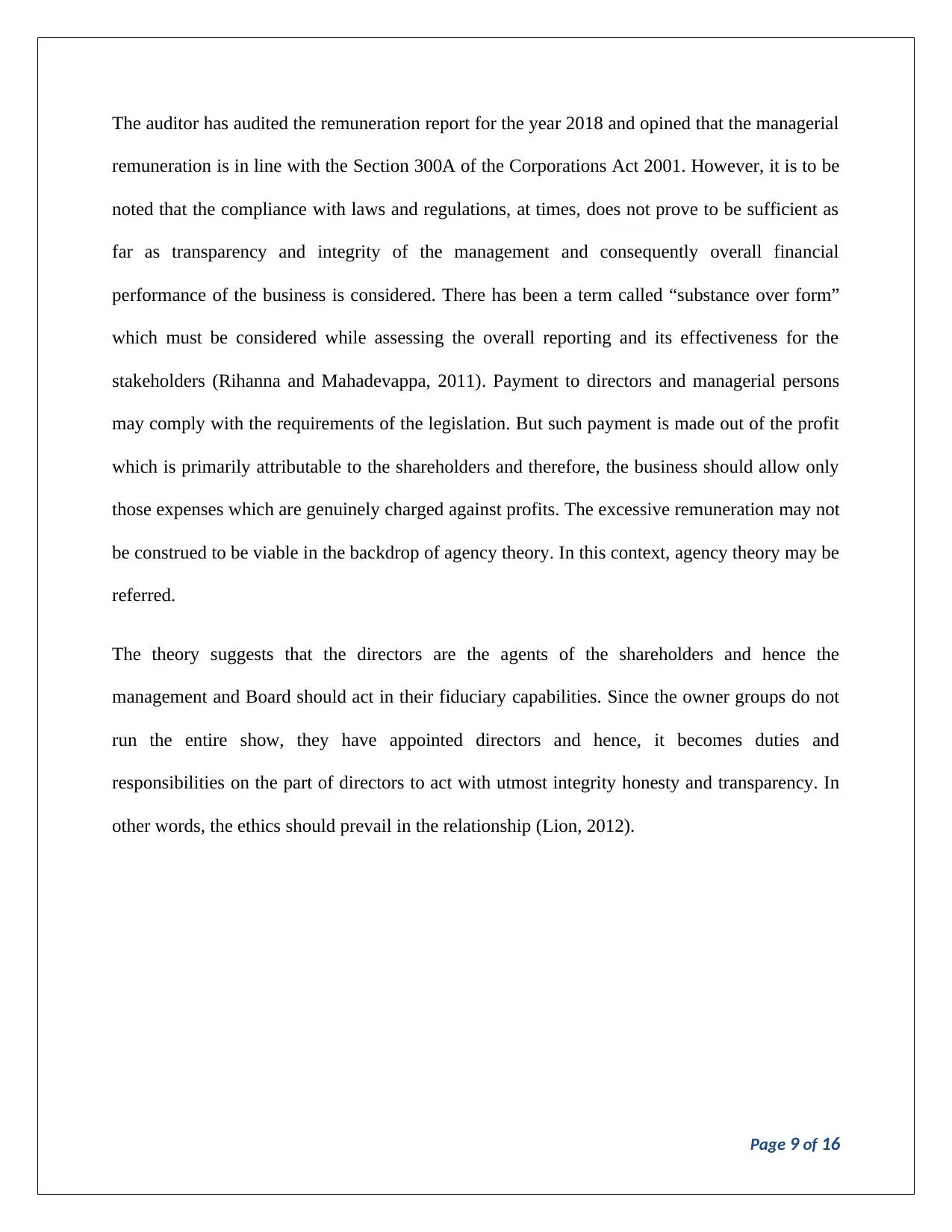
The auditor has audited the remuneration report for the year 2018 and opined that the managerial
remuneration is in line with the Section 300A of the Corporations Act 2001. However, it is to be
noted that the compliance with laws and regulations, at times, does not prove to be sufficient as
far as transparency and integrity of the management and consequently overall financial
performance of the business is considered. There has been a term called “substance over form”
which must be considered while assessing the overall reporting and its effectiveness for the
stakeholders (Rihanna and Mahadevappa, 2011). Payment to directors and managerial persons
may comply with the requirements of the legislation. But such payment is made out of the profit
which is primarily attributable to the shareholders and therefore, the business should allow only
those expenses which are genuinely charged against profits. The excessive remuneration may not
be construed to be viable in the backdrop of agency theory. In this context, agency theory may be
referred.
The theory suggests that the directors are the agents of the shareholders and hence the
management and Board should act in their fiduciary capabilities. Since the owner groups do not
run the entire show, they have appointed directors and hence, it becomes duties and
responsibilities on the part of directors to act with utmost integrity honesty and transparency. In
other words, the ethics should prevail in the relationship (Lion, 2012).
Page 9 of 16
remuneration is in line with the Section 300A of the Corporations Act 2001. However, it is to be
noted that the compliance with laws and regulations, at times, does not prove to be sufficient as
far as transparency and integrity of the management and consequently overall financial
performance of the business is considered. There has been a term called “substance over form”
which must be considered while assessing the overall reporting and its effectiveness for the
stakeholders (Rihanna and Mahadevappa, 2011). Payment to directors and managerial persons
may comply with the requirements of the legislation. But such payment is made out of the profit
which is primarily attributable to the shareholders and therefore, the business should allow only
those expenses which are genuinely charged against profits. The excessive remuneration may not
be construed to be viable in the backdrop of agency theory. In this context, agency theory may be
referred.
The theory suggests that the directors are the agents of the shareholders and hence the
management and Board should act in their fiduciary capabilities. Since the owner groups do not
run the entire show, they have appointed directors and hence, it becomes duties and
responsibilities on the part of directors to act with utmost integrity honesty and transparency. In
other words, the ethics should prevail in the relationship (Lion, 2012).
Page 9 of 16
⊘ This is a preview!⊘
Do you want full access?
Subscribe today to unlock all pages.

Trusted by 1+ million students worldwide
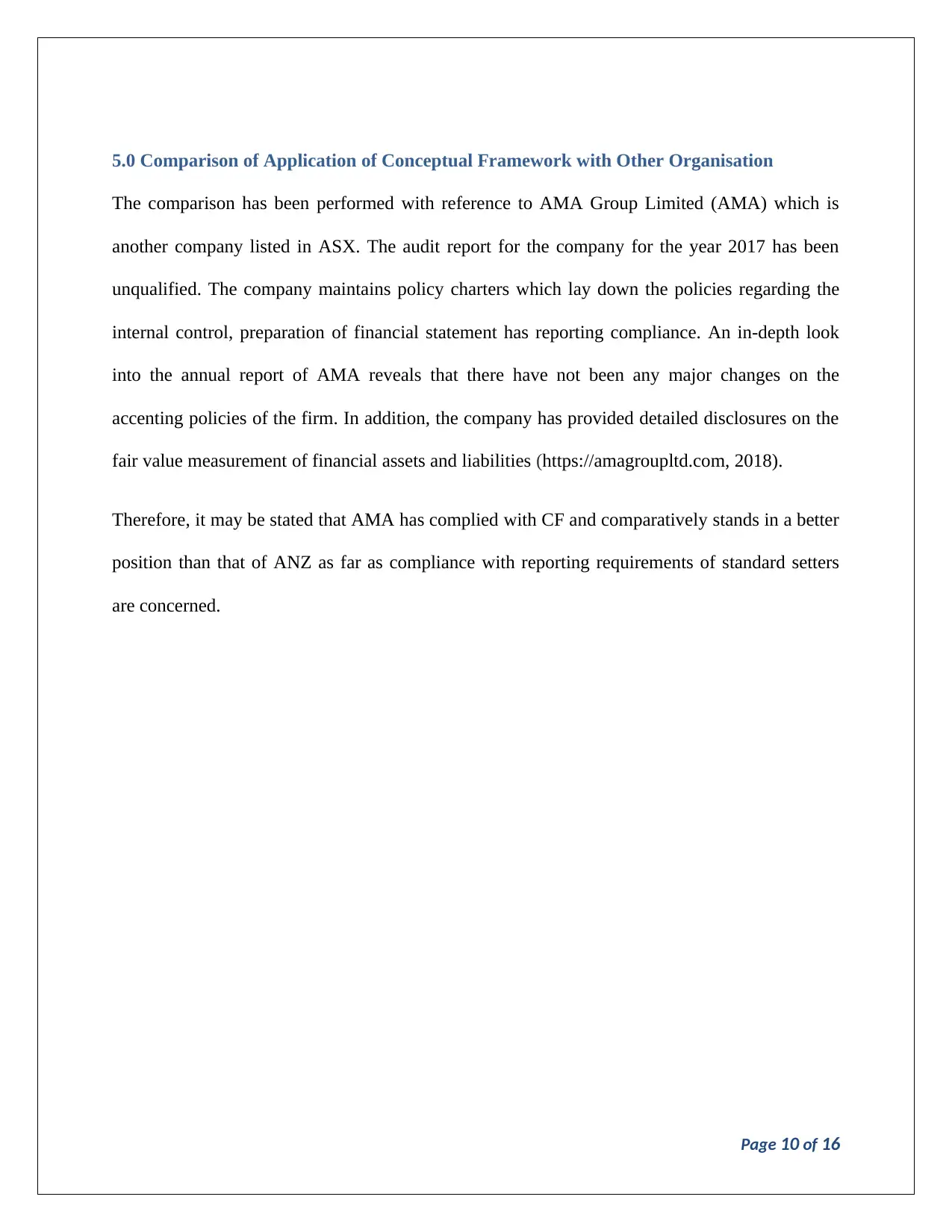
5.0 Comparison of Application of Conceptual Framework with Other Organisation
The comparison has been performed with reference to AMA Group Limited (AMA) which is
another company listed in ASX. The audit report for the company for the year 2017 has been
unqualified. The company maintains policy charters which lay down the policies regarding the
internal control, preparation of financial statement has reporting compliance. An in-depth look
into the annual report of AMA reveals that there have not been any major changes on the
accenting policies of the firm. In addition, the company has provided detailed disclosures on the
fair value measurement of financial assets and liabilities (https://amagroupltd.com, 2018).
Therefore, it may be stated that AMA has complied with CF and comparatively stands in a better
position than that of ANZ as far as compliance with reporting requirements of standard setters
are concerned.
Page 10 of 16
The comparison has been performed with reference to AMA Group Limited (AMA) which is
another company listed in ASX. The audit report for the company for the year 2017 has been
unqualified. The company maintains policy charters which lay down the policies regarding the
internal control, preparation of financial statement has reporting compliance. An in-depth look
into the annual report of AMA reveals that there have not been any major changes on the
accenting policies of the firm. In addition, the company has provided detailed disclosures on the
fair value measurement of financial assets and liabilities (https://amagroupltd.com, 2018).
Therefore, it may be stated that AMA has complied with CF and comparatively stands in a better
position than that of ANZ as far as compliance with reporting requirements of standard setters
are concerned.
Page 10 of 16
Paraphrase This Document
Need a fresh take? Get an instant paraphrase of this document with our AI Paraphraser
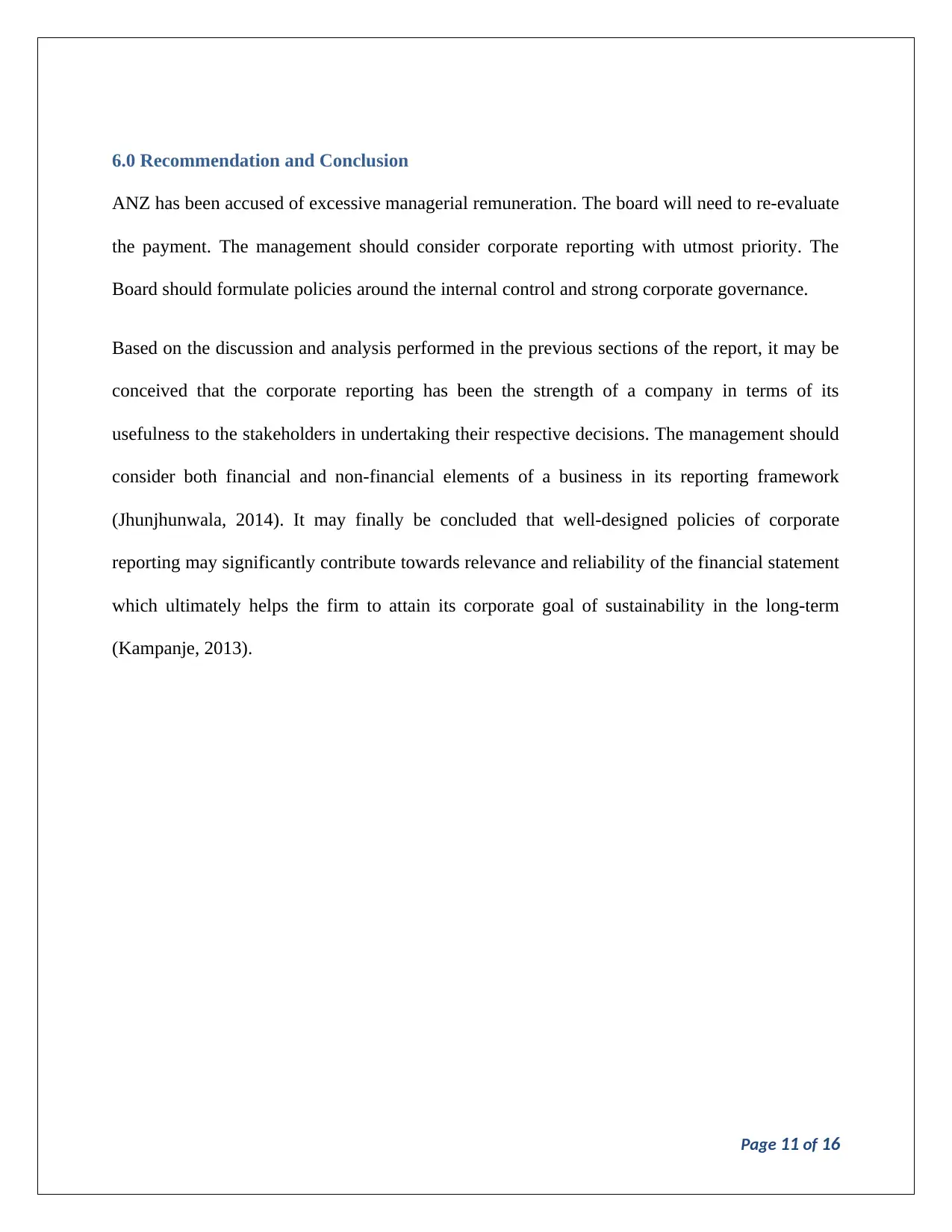
6.0 Recommendation and Conclusion
ANZ has been accused of excessive managerial remuneration. The board will need to re-evaluate
the payment. The management should consider corporate reporting with utmost priority. The
Board should formulate policies around the internal control and strong corporate governance.
Based on the discussion and analysis performed in the previous sections of the report, it may be
conceived that the corporate reporting has been the strength of a company in terms of its
usefulness to the stakeholders in undertaking their respective decisions. The management should
consider both financial and non-financial elements of a business in its reporting framework
(Jhunjhunwala, 2014). It may finally be concluded that well-designed policies of corporate
reporting may significantly contribute towards relevance and reliability of the financial statement
which ultimately helps the firm to attain its corporate goal of sustainability in the long-term
(Kampanje, 2013).
Page 11 of 16
ANZ has been accused of excessive managerial remuneration. The board will need to re-evaluate
the payment. The management should consider corporate reporting with utmost priority. The
Board should formulate policies around the internal control and strong corporate governance.
Based on the discussion and analysis performed in the previous sections of the report, it may be
conceived that the corporate reporting has been the strength of a company in terms of its
usefulness to the stakeholders in undertaking their respective decisions. The management should
consider both financial and non-financial elements of a business in its reporting framework
(Jhunjhunwala, 2014). It may finally be concluded that well-designed policies of corporate
reporting may significantly contribute towards relevance and reliability of the financial statement
which ultimately helps the firm to attain its corporate goal of sustainability in the long-term
(Kampanje, 2013).
Page 11 of 16
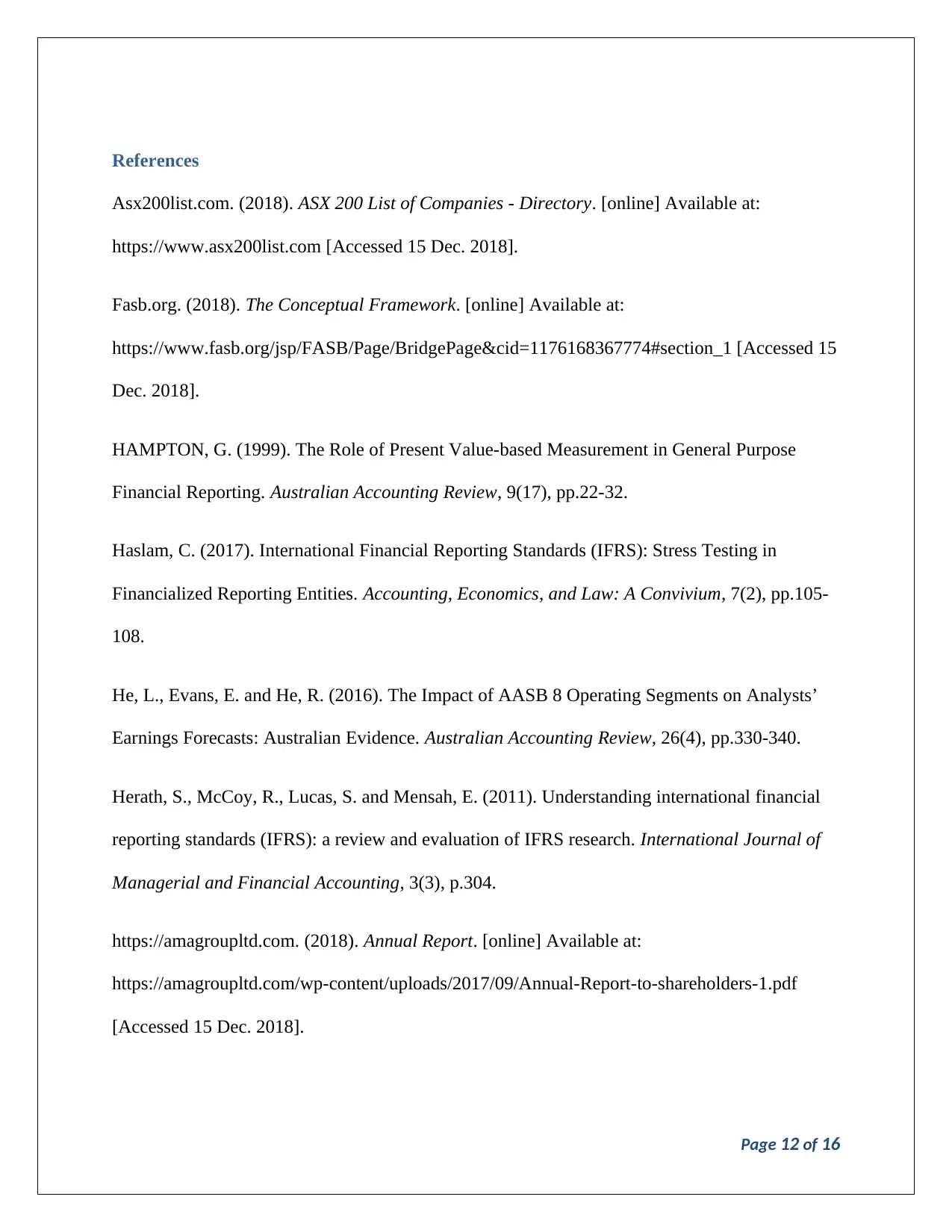
References
Asx200list.com. (2018). ASX 200 List of Companies - Directory. [online] Available at:
https://www.asx200list.com [Accessed 15 Dec. 2018].
Fasb.org. (2018). The Conceptual Framework. [online] Available at:
https://www.fasb.org/jsp/FASB/Page/BridgePage&cid=1176168367774#section_1 [Accessed 15
Dec. 2018].
HAMPTON, G. (1999). The Role of Present Value-based Measurement in General Purpose
Financial Reporting. Australian Accounting Review, 9(17), pp.22-32.
Haslam, C. (2017). International Financial Reporting Standards (IFRS): Stress Testing in
Financialized Reporting Entities. Accounting, Economics, and Law: A Convivium, 7(2), pp.105-
108.
He, L., Evans, E. and He, R. (2016). The Impact of AASB 8 Operating Segments on Analysts’
Earnings Forecasts: Australian Evidence. Australian Accounting Review, 26(4), pp.330-340.
Herath, S., McCoy, R., Lucas, S. and Mensah, E. (2011). Understanding international financial
reporting standards (IFRS): a review and evaluation of IFRS research. International Journal of
Managerial and Financial Accounting, 3(3), p.304.
https://amagroupltd.com. (2018). Annual Report. [online] Available at:
https://amagroupltd.com/wp-content/uploads/2017/09/Annual-Report-to-shareholders-1.pdf
[Accessed 15 Dec. 2018].
Page 12 of 16
Asx200list.com. (2018). ASX 200 List of Companies - Directory. [online] Available at:
https://www.asx200list.com [Accessed 15 Dec. 2018].
Fasb.org. (2018). The Conceptual Framework. [online] Available at:
https://www.fasb.org/jsp/FASB/Page/BridgePage&cid=1176168367774#section_1 [Accessed 15
Dec. 2018].
HAMPTON, G. (1999). The Role of Present Value-based Measurement in General Purpose
Financial Reporting. Australian Accounting Review, 9(17), pp.22-32.
Haslam, C. (2017). International Financial Reporting Standards (IFRS): Stress Testing in
Financialized Reporting Entities. Accounting, Economics, and Law: A Convivium, 7(2), pp.105-
108.
He, L., Evans, E. and He, R. (2016). The Impact of AASB 8 Operating Segments on Analysts’
Earnings Forecasts: Australian Evidence. Australian Accounting Review, 26(4), pp.330-340.
Herath, S., McCoy, R., Lucas, S. and Mensah, E. (2011). Understanding international financial
reporting standards (IFRS): a review and evaluation of IFRS research. International Journal of
Managerial and Financial Accounting, 3(3), p.304.
https://amagroupltd.com. (2018). Annual Report. [online] Available at:
https://amagroupltd.com/wp-content/uploads/2017/09/Annual-Report-to-shareholders-1.pdf
[Accessed 15 Dec. 2018].
Page 12 of 16
⊘ This is a preview!⊘
Do you want full access?
Subscribe today to unlock all pages.

Trusted by 1+ million students worldwide
1 out of 16
Related Documents
Your All-in-One AI-Powered Toolkit for Academic Success.
+13062052269
info@desklib.com
Available 24*7 on WhatsApp / Email
![[object Object]](/_next/static/media/star-bottom.7253800d.svg)
Unlock your academic potential
Copyright © 2020–2025 A2Z Services. All Rights Reserved. Developed and managed by ZUCOL.




